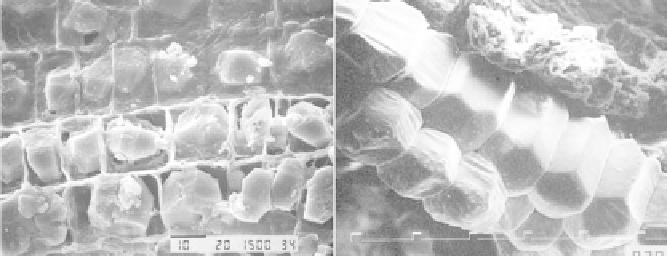Geoscience Reference
In-Depth Information
cells of the parenchyma of the sub-apical zone (near the tip) absorb
calcium, which later precipitates in the vacuoles as CaCO
3
. These
vacuoles, thus invaded, swell and end up occupying almost the entire
cell that dies, gradually leading to death of the root (Fig. 7.16).
Fig. 7.16
Calcifi ed cells. Left, the cell walls and their vacuoles are clearly seen transformed
to calcite crystals. But observed on a sample obtained by sectioning, the vacuoles have lost
their rounded appearance on the surface (
photo
: A. Guyon and Catherine Grimaldi). Right,
the calcifi ed cells are swollen and exhibit angles of 120°, because of the rhombohedral cal-
cite they contain (
photo
: B. Jaillard and A. Guyon).
After their formation, these calcite crystals (
calcified root cells
) are
released into the soil. They are identified by various features: their size
(10
µ
m to 125
µ
m; average 80
µ
m), their very rounded shape and at the
same time their 60-120° angles, their surface dotted with irregularities
that have been moulded in the shape characteristic of cell walls or
vacuoles, and their composition (they contain phosphates—an indication
of their biological origin). In some soils, composed of clays and silts,
these cells end up forming a fraction of fine sands that can represent
10 per cent of the total fine earth.
As for the plant, the absorption of cations is compensated for by the
excretion of H
+
ions that serve to dissolve the surrounding soil and to
make various other ions available.
Water transports the calcium up to the boundary with roots where it
precipitates by drying. We therefore often find, particularly in sandy
soils, various kinds of empty pipes formed of calcite (
root tubes
,
root
casts
). They can be 10 or 20 to 50 cm long and a few cm in diameter.
Our review is not complete because other forms of accumulation in
soils should have been mentioned (pisoliths, masses, concretions, etc.).
Root tubes

